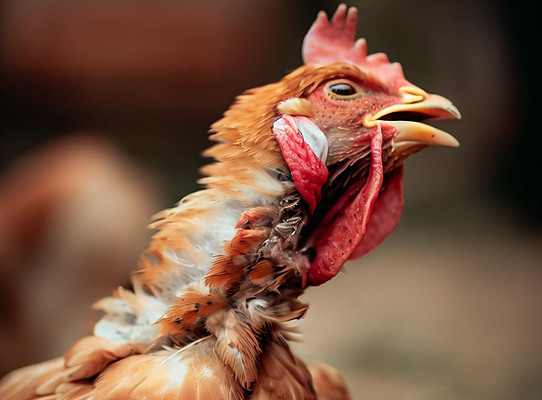Wow! That’s a mouthful! What the heck is infectious laryngotracheitis in chickens anyway?
Laryngotracheitis is a respiratory disease primarily affecting chickens older than 14 weeks. It is caused by the Infectious Laryngotracheitis Virus (ILTV), which belongs to the family Herpesviridae. This disease is quite contagious and can spread rapidly through a flock.
What Parts Of The Chicken Does It Affect?
Laryngotracheitis primarily affects the respiratory system of chickens. Here are the specific parts that are impacted:
Larynx: This is essentially the chicken’s voice box, located at the upper part of the trachea. The virus can cause inflammation and irritation in this area, leading to respiratory distress.
Trachea: The trachea, or windpipe, is a crucial part of the respiratory system that allows air to pass to and from the lungs. Laryngotracheitis can cause the trachea lining to become inflamed and produce excessive mucus, obstructing the airway.
Conjunctiva: While not a part of the respiratory system, the conjunctiva (the tissue lining the eyelids and covering the white part of the eye) can also be affected, leading to conjunctivitis, characterized by red, swollen, and watery eyes.
Lungs: In severe cases, the infection can spread to the lungs, causing pneumonia and further complicating the respiratory distress in the birds.
How do I Know If My Chickens Have Laryngotracheitis? What Are The Symptoms, And How Is It Spread?
Diagnosis is generally based on the clinical signs and symptoms exhibited by the birds. This includes a chicken stretching out its neck and gasping for air, head shaking to remove obstructions, and coughing and sneezing.
However, laboratory tests such as virus isolation and PCR (polymerase chain reaction) can be conducted for a definitive diagnosis on samples taken from the affected birds.
Symptoms: Infected birds may show signs of coughing, sneezing, nasal discharge, and difficulty breathing. In severe cases, birds might exhibit extended necks and gasping for air due to obstruction in the trachea.
You might also notice a decrease in egg production among laying hens.
Transmission: The virus can be transmitted through direct contact with infected birds or indirectly through exposure to contaminated equipment, feed, water, or air.
It’s important to note that the virus doesn’t survive for long in the environment, so cleaning and disinfecting the coop once a week for several weeks will hopefully resolve the problem.
Is There More Than One Type Of Larygotracheitis?
Unfortunately, there are two types of the disease, or to put it more accurately, there are two degrees of the disease: Mild and Acute.
Mild Laryngotracheitis
In the mild form of laryngotracheitis, the symptoms are less severe and might even go unnoticed if one is not keenly observing their flock. Here are the characteristics and potential symptoms:
- Subtle Symptoms: Birds might exhibit mild respiratory signs such as slight coughing and sneezing.
- Slow Spread: The disease spreads slowly within the flock, and not all birds may be affected.
- Low Mortality Rate: The mortality rate in a flock experiencing a mild outbreak is generally low.
- Recovery: Many birds recover with supportive care and proper management, although it might take some time.
Acute Laryngotracheitis
On the other hand, the acute form of the disease is much more severe, with the following characteristics:
- Severe Symptoms: Birds show pronounced signs of respiratory distress, including severe coughing, gasping for air, and extended necks while trying to breathe.
- Rapid Spread: The disease spreads quickly among the flock, affecting many birds in a short period.
- High Mortality Rate: Unfortunately, the acute form of laryngotracheitis can have a high mortality rate, with many birds succumbing to the disease.
- Blood-streaked Mucus: In acute cases, birds might expel blood-streaked mucus due to the damage to the tracheal lining.
- Drop in Egg Production: Laying hens might exhibit a significant drop in egg production, and the quality of the eggs may also be affected.
Understanding the difference between the mild and acute forms of laryngotracheitis can help implement timely interventions.
How Do You Treat Laryngotracheitis?
Unfortunately, there is no specific treatment for laryngotracheitis. Supportive care, such as ensuring birds have access to clean water and nutritious food, can help manage the disease. In some cases, antibiotics might be administered to control secondary bacterial infections.
Prevention: Vaccination is the most effective way to prevent laryngotracheitis. Vaccinating the birds at an appropriate age is advisable to build immunity against the virus. Also, maintaining good biosecurity practices, such as regular cleaning and disinfection of the poultry environment, can help prevent disease outbreaks.
How Can I Prevent My Chickens From Getting Laryngotracheitis?
There are three types of vaccines for laryngotracheitis. The first and least desirable is the chicken embryo origin vaccine. The second is the recombinant vaccine, and the third and most widely used is the tissue culture origin vaccine.
I will focus on the tissue culture origin vaccine because it is the easiest to administer, arguably the safest to use, and causes the least amount of problems in the flock.
Tissue Culture Origin Vaccine
This is the most widely used type of vaccine due to its safety and efficacy:
- Production: The vaccine is produced by growing the ILTV virus in tissue culture cells in a controlled laboratory environment.
- Preferred Choice: It is preferred for many poultry keepers because it offers a good balance between safety and efficacy, with a lower risk of adverse reactions compared to the chicken embryo origin vaccine.
- Administration: It can be administered through various routes, including drinking water, spray, or eye drop, making it versatile and user-friendly for different scales of poultry keeping.
There You Have It
One thing I failed to mention is that when all else fails, sometimes you have to start over, including everything that entails… new birds, a total cleanout including disinfection, and a lot of waiting for your new crew to get old enough to lay those incredible edible eggs.
It’s a sad affair when that happens. I know. I love to curse and threaten my roosters, mostly because they don’t know their manners. But when something actually does happen to them, like a car, a fox, or an eagle, it breaks the heart. I digress.
Laryngotracheitis is real, and it’s out there, so take care of your birds, and be wary of new birds coming into your flock, buying used equipment, and traveling to kindred chicken keeper’s establishments. You never know what you might bring home.
Thanks!
Dave
Chickenmethod.com

